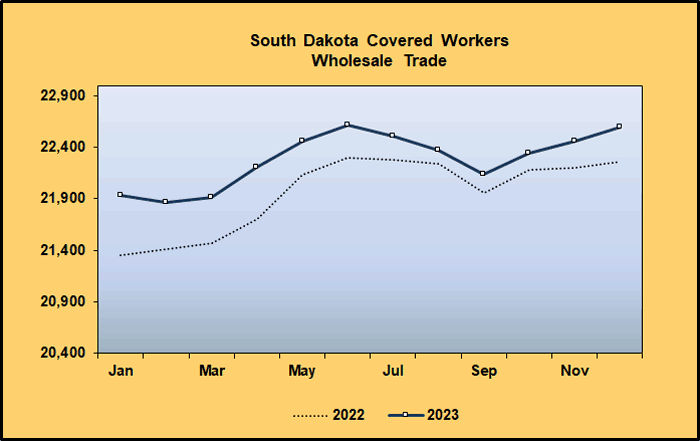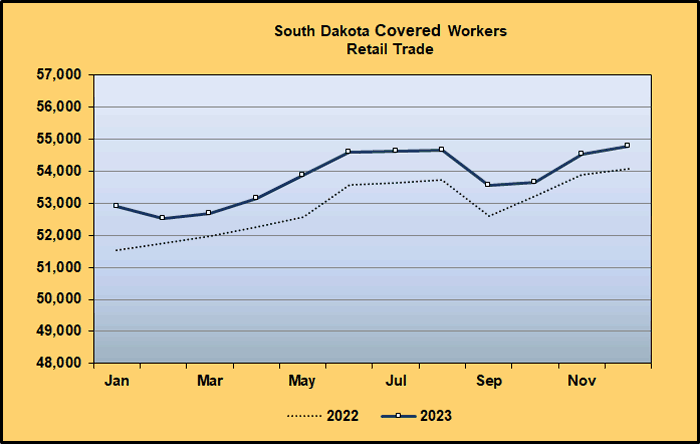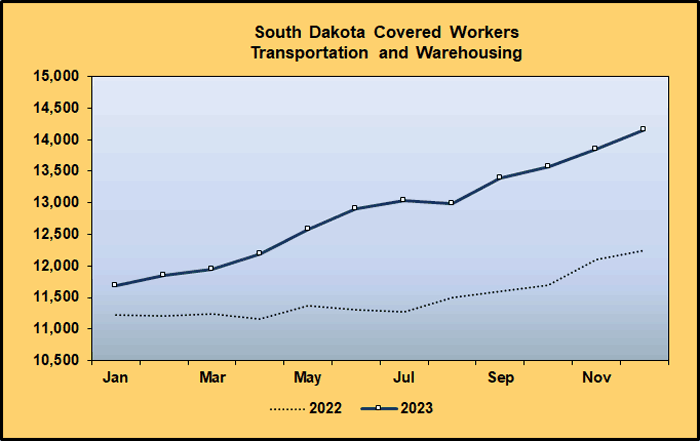- Home to LMIC
- Virtual Labor Market Data System
- Career Exploration & Planning
- Consumer Price Index
- Demographics
- Economic Snapshot
- Employee Benefits
- Employment Projections
- Labor Force & Unemployment
- Labor Supply
- Overview of the Current Labor Market
- Surveys We Conduct
- Wages & Income
- Workers by Industry
- Tools & Resources
- Publications
- References
- What's New
- Can't Find It?
Labor Market Information Center
2023 Annual Report
Quarterly Census of Employment and Wages
Trade, Transportation and Utilities Supersector
The Trade, Transportation and Utilities supersector is comprised of the Wholesale Trade sector, the Retail Trade sector, the Transportation and Warehousing sector and the Utilities sector. Businesses within this supersector sell or arrange the sale of goods and supplies and retail merchandise to the public, provide transportation of passengers or cargo or generate and/or distribute electricity, gas or water.
| South Dakota Covered Workers and Pay 2023 |
|||
| Supersector, Sector and Subsector | Number of Establishments | Average Number of Workers | Annual Pay |
| Trade, Transportation and Utilities | 8,993 | 90,936 | $51,095 |
| Wholesale Trade | 3,312 | 22,284 | $79,785 |
| Merchant Wholesalers, Durable Goods | 1,746 | 11,260 | $86,469 |
| Merchant Wholesalers, Nondurable Goods | 1,392 | 10,564 | $71,187 |
| Wholesale Trade Agents and Brokers | 174 | 461 | $113,389 |
| Retail Trade | 3,978 | 53,793 | $36,840 |
| Motor Vehicle and Parts Dealers | 558 | 8,285 | $61,564 |
| Building Material and Garden Equipment and Supplies Dealers | 409 | 6,149 | $42,714 |
| Food and Beverage Retailers | 387 | 9,015 | $25,421 |
| Furniture, Home Furnishings, Electronics, and Appliance Retailers | 335 | 2,793 | $51,083 |
| General Merchandise Retailers | 265 | 9,579 | $30,489 |
| Health and Personal Care Retailers | 264 | 2,125 | $42,046 |
| Gasoline Stations and Fuel Dealers | 656 | 7,438 | $28,463 |
| Clothing, Clothing Accessories, Shoe, and Jewelry Retailers | 388 | 2,595 | $24,171 |
| Sporting Goods, Hobby, Musical Instrument, Book, and Miscellaneous Retailers | 716 | 5,816 | $31,185 |
| Transportation and Warehousing | 1,526 | 12,848 | $53,137 |
| Air Transportation | 30 | 87 | $91,638 |
| Truck Transportation | 1,070 | 5,068 | $61,853 |
| Transit and Ground Passenger Transportation | 79 | 1,241 | $28,239 |
| Pipeline Transportation | 15 | 132 | $120,315 |
| Scenic and Sightseeing Transportation | 15 | 109 | $31,956 |
| Support Activities for Transportation | 165 | 1,135 | $57,646 |
| Postal Service | 9 | 26 | $25,685 |
| Couriers and Messengers | 99 | 2,361 | $47,144 |
| Warehousing and Storage | 44 | 2,689 | $48,138 |
| Utilities | 177 | 2,011 | $101,426 |
| Utilities | 177 | 2,011 | $101,426 |
| Totals may not add due to rounding. Data subject to revision. Produced by the Labor Market Information Center, South Dakota Department of Labor and Regulation, in cooperation with the U.S. Bureau of Labor Statistics. |
|||
Wholesale Trade
NAICS Sector 42
The Wholesale Trade sector consists of establishments engaged in wholesaling merchandise and rendering services incidental to the sale of merchandise. The merchandise described in this sector includes the outputs of agriculture, mining, manufacturing, and certain information industries, such as publishing. The wholesaling process in an intermediate step in the distribution of merchandise, as establishments sell merchandise to other businesses and normally operate from a warehouse or office.
Wholesale Trade worker levels trended up in 2023 for the third year in a row. Wholesale Traded added 328 workers (1.5%), reaching 22,284 workers in 2023. The average annual wage grew 4.2% to $79,785. Growth in Wholesale Trade correlates with increased demand in industries such as Retail Trade and Manufacturing. As those sectors grow, the need for more workers to manage inventory and distribution also increases.
Merchant Wholesalers, Durable Goods (NAICS 423) added 183 workers (1.7%) in 2023. The average annual pay increased $3,833 (4.6%). Businesses in this subsector sell capital or durable goods to other businesses. Durable goods are new or used items that have a normal life expectancy of three years or more. Durable goods include construction equipment, farm machinery, furniture, computer equipment, jewelry and household appliances. Gains were spread throughout many of the industries as establishments increased their workforce in order to keep up with demand. The top three contributors to worker level growth in Merchant Wholesale, Durable Goods were in the following industries: Professional and Commercial Equipment and Supplies Merchant Wholesalers (NAICS 4234), Household Appliances and Electrical and Electronic Goods Merchant Wholesalers (NAICS 4236), and Machinery, Equipment, and Supplies Merchant Wholesalers (NAICS 4238).
Merchant Wholesalers, Nondurable Goods (NAICS 424) worker levels added 152 (1.5%) from 2022 to 2023. The annual pay increased $2,646 (3.9%), reaching a 2023 average annual wage of $71,187. Establishments in this industry sell nondurable goods to other businesses. Nondurable goods generally have a normal life expectancy of less than three years. The goods include paper and paper products, farm products, drugs, petroleum, food, apparel, and newspapers. Growth in this subsector is due to increases in Farm Product Raw Material Merchant Wholesalers (NAICS 4245) and Miscellaneous Nondurable Goods Merchant Wholesalers (NAICS 4249).
The last subsector group in this industry is the Wholesale Trade Agents and Brokers subsector (NAICS 425). This subsector had a loss of six workers (1.3%) in 2023, dropping to 461 workers. The annual pay increased $168 (0.1%) from 2022 to 2023. This subsector has the highest annual pay out of the three subsectors with a 2023 annual wage of $113,389. Brokers and agents in this subsector act on behalf of buyers or sellers in the wholesale distribution of durable or nondurable goods. The pay structure is usually salaried, with distribution of bonuses and profits, resulting in some years of elevated pay.

Retail Trade
NAICS Sectors 44-45
Retail Trade continued to trend up for the third consecutive year with the addition of 889 workers (1.7%). Retail Trade is ranked third out of all sectors in the number of establishments (3,978) and second in employment (53,793 workers). Annual pay gained $959 (2.7%), reaching an annual average of $36,840 in 2023. Establishments in Retail Trade employ many part-time workers, with many arranging their schedules around school or another job. Six out of the nine subsectors had gains in worker levels, and every subsector had growth in annual pay from 2022 to 2023.
Population growth along with increases in consumer spending play a huge role in the workforce levels in Retail Trade. Increased consumer spending influences the demand for retail goods, leading to more jobs in this sector. As the population grows, establishments also expand their footprint in order to meet the needs of the community.
Sporting Goods, Hobby, Musical Instrument, Book, and Miscellaneous Retailers (NAICS 459) added the largest number of workers from 2022 to 2023. This subsector added 417 workers (7.7%). The average annual pay increased $1,497 (5.0%), jumping to average annual pay of $31,185 in 2023. Industries in this subsector are involved in retailing sporting equipment, musical instruments and other specific leisure activities. Growing interest in health, fitness, and hobbies has increased the demand for establishments in this subsector. Sewing supply stores, sporting goods retailers, florists, bookstores, hobby shops, pet supply stores and toy stores are examples of establishments that would be included in this subsector.
General Merchandise Retailers (NAICS 455) gained 321 workers (3.5%) from 2022 to 2023. The General Merchandise Retailers subsector accounted for 17.8% of the workforce in Retail Trade in 2023. The average annual pay increased $554 (1.9%). This subsector added 21 establishments in 2023. Department stores, supercenters, dollar stores and general stores are the type of establishments included in this subsector. Growth in the General Merchandise Retailers subsector occurred primarily in Warehouse Clubs, Supercenters, and Other General Merchandise Retailers.
Gasoline Stations and Fuel Dealers (NAICS 457) added 299 workers (4.2%), reaching 7,438 workers in 2023. The average annual pay increased 4.5%, increasing $1,231. Gasoline service stations, truck stops, and gasoline stations with convenience stores are examples of establishments included in this subsector. Establishments in this subsector may also provide automotive repair services.
Motor Vehicle and Parts Dealers (NAICS 441) gained 171 workers (2.1%). The average annual wage increased $456 (0.7%). With a 2023 average annual wage of $61,564, the Motor Vehicle and Parts Dealers subsector has the largest annual wage in Retail Trade. Boat dealers, utility trailer dealers, new and used car dealers, auto supply stores and tire dealers are examples of establishments in this subsector.
Food and Beverage Retailers (NAICS 445) worker levels had a loss of 295 (3.2%) over the year. Worker losses in Grocery and Convenience Retailers accounted for a majority of this decline. Despite declines in employment, the average annual pay increased $1,073 (4.4%). Establishments included in this subsector are grocery stores, meat markets, candy stores, and liquor stores.

Transportation and Warehousing
NAICS Sectors 48-49
The Transportation and Warehousing sector include industries that provide passenger and cargo transportation, warehousing and storage for goods, scenic and sightseeing transportation, and support activities for transportation. It is common for a business in this sector to operate a network of facilities, workers and equipment over a widespread area.
The Transportation and Warehousing sector splits into several subsectors:
- The various modes of transportation (air, rail, water, road, and pipeline)
- Warehousing and storage
- Establishments providing support activities for transportation
- Establishments providing passenger transportation for scenic and sightseeing purposes
- Postal services and courier services
Transportation and Warehousing worker levels rose 11.7% with the addition of 1,348 workers in 2023. Significant employment gains in the Warehousing and Storage subsector accounted for the growth. The average annual wage increased $1,194 (2.3%), reaching an average annual pay of $53,137 in 2023. Five subsectors in the Transportation and Warehousing sector had employment growth, and eight had gains in earnings from 2022 to 2023.
The Warehousing and Storage (NAICS 493) subsector accounted for the growth within the Transportation and Warehousing sector. Worker levels rose 119.7% with the addition of 1,465 workers. The average annual wage declined $1,250 (2.5%). Establishments in this subsector include refrigerated warehousing, grain elevator storage, lumber storage terminals, bulk petroleum storage, and general warehousing. Growth is related to establishments expanding their workforce in order to keep up with demand.
The Air Transportation (NAICS 481) subsector annual pay rose $5,532 (6.4%), jumping to an average annual pay of $91,638 in 2023. This subsector is filled with many skilled occupations that contribute to the high annual pay. Worker levels declined 11 (11.2%). Industries in this subsector provide air transportation of passengers and/or cargo using an aircraft.
Couriers and Messengers (NAICS 492) subsector’s employment increased 51 (2.2%) in 2023. The average annual pay for this subsector increased $1,811 (4.0%) to $47,144. Couriers and Messengers provide intercity, local, and/or international delivery of parcels and documents without operating under a universal service obligation. The restriction to small parcels partly distinguishes these establishments from those in the transportation industries. Worker level gains can be tied to increases in couriers and express delivery services.

Utilities
NAICS Sector 22
The Utilities sector (NAICS 22) contains just one three-digit NAICS subsector, also titled Utilities (NAICS 221). The Utilities sector added three establishment and increased by 18 workers or 0.9% over the year. As of 2023, there were 2,011 workers in the Utilities sector. The annual pay for 2023 was $101,426, an increase of $2,301 or 2.3% compared to 2022. The Utilities sector has one of the highest annual pay statistics. This sector ranked second overall in annual wage in 2023, following only the Management of Companies and Enterprises (NAICS Sector 55).
Establishments in this subsector provide electric power, natural gas, steam supply, water supply, and sewage removal through a permanent infrastructure of lines, mains, and pipes. Within this sector, the specific activities vary by utility. Electric power encompasses transmission and distribution; natural gas includes distribution; steam supply involves distribution; water supply offers treatment and distribution; while sewage removal includes collection and disposal of waste. Waste management services are excluded from this sector since they do not use sewer systems or sewage treatment facilities; however, they do collect, treat, and dispose waste materials.
While this sector ranks high in annual wage, it runs toward the bottom in number of establishments and employment. The high wage rank reveals the critical services this sector provides. The demand for these services will likely boost employment in the upcoming years as South Dakota’s population increases. According to the Census Bureau, population estimate for South Dakota from 2020 to 2023 showed an increase of 32,650 residents or 3.7%. As the number of residences increase, there is a direct relationship to the need for more workers and establishments that provide power, gas, and water.

